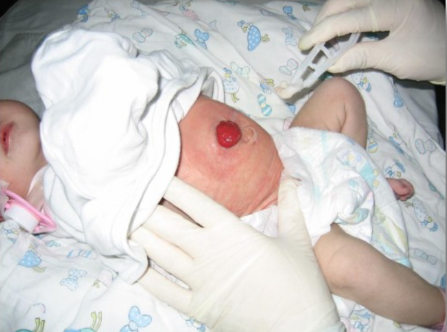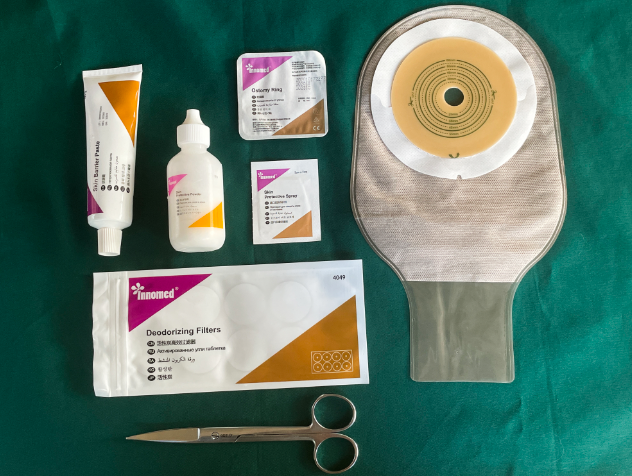Pediatric enterostomy is a temporary fecal diversion to save anorectal congenital malformations, and it is also an important means to save the lives of children. According to statistics, the incidence of enterostomy complications in children is higher than that in adults, accounting for 28-74%, and children have more stomas. It is a temporary stoma, because the child is young, does not cooperate, and has delicate skin. If the care is not appropriate, it may easily cause skin problems such as redness, swelling, erosion, and ulcers around the stoma. Whether home care is effective also determines the recovery of the stoma. This article will introduce to you how to properly care for children with a stoma and prevent stoma complications. Please follow me to take a look.
Ostomy Care Observation:
Observe the stoma: Check whether there is any bleeding on the stoma on the day after the operation. If there is slight bleeding, you can use Alginate Dressing. When it comes into contact with wound exudate, it forms sodium alginate through ion exchange, which has the ability to absorb a large amount of liquid. 5-7 times that of gauze. Calcium ions in the dressing are released into the wound, inducing platelet activation and production of blood growth factors, thereby stopping bleeding and accelerating wound healing.
On the second day after the operation, the enterostomy can be opened routinely. The normal mucosa is bright red and covered with capillaries. Sodium oxide wet compress, once every 30 minutes, twice a day, usually recovers within half a month. If the mucous membrane turns black, it means intestinal necrosis is caused by ischemia, which often occurs after 24-48 hours after the operation. Please inform the doctor immediately.
How to properly care for a child's stoma?
Environment preparation:
The indoor light is sufficient and the temperature is >25°C. To keep warm, you must prepare stoma items: a one-piece ostomy bag, Skin Protective Spray, normal saline, wet wipes
First, clean the skin around the stoma, rinse the skin around the stoma with sterile normal saline, and dry the skin sufficiently to avoid affecting the adhesion between the stoma bag and the skin pair, and then cut it on the stoma chassis according to the size of the stoma. Cut out 2 mm larger than the measured enterostomy. Don't make it too small. If the opening is too small, it will affect the blood supply of the intestine. If it is too large, the feces from the stoma will leak to the skin around the stoma, causing skin infection. Then using Skin Protective Spray will naturally form a protective film on the skin. Since the stoma will discharge a large amount of small intestinal secretions in the early stage, it will cause irritation to the surrounding skin. The advantage is that it can protect the skin well and prevent skin friction from causing damage. The one-piece ostomy bag is attached, and the edge of the chassis should be slightly pressed to prevent leakage.
Application skills of ostomy bags:
1. Minimize frequent removal of chassis.
2. Replace in time when leakage occurs.
3. Keep your skin dry when applying.
4. Be gentle when changing the pouch.
Stoma sticking and skin care principles:
1. Properly clean the skin around the stoma, strengthen the protection of the skin around the stoma, and prevent secondary damage.
2. Unable to control the output of the stoma. It happens automatically in due course. Whether it is a urostomy, ileostomy, or colostomy, stoma output may also be relatively constant throughout the day.
3. In some cases, the stoma may not work right away. Usually, your child's doctor will want them to stay in the hospital after the operation until they see some discharge from your child's stoma. Talk to your child's doctor about possible delayed stoma drainage after you go home.
4. The stoma may also be red and swollen for a while. However, it may become smaller as the stoma heals. It is also important to remember that a stoma will grow as the child grows. Over time, this may result in the need for different sizes of pediatric ostomy products to accommodate your child's changing body.
Diet and Sleep:
Drink as much fluid as possible, children with an ostomy are more likely to become dehydrated. If you notice that the urine is black, it may mean your child is not drinking enough water. It is also important for moms to know which foods are good and bad for their children.
· Foods that may cause gas: Yogurt, buttermilk, cranberry juice, parsley
· Foods to avoid with stoma blockage: Nuts and seeds
· Foods that may cause loose stools: Baked beans, tomatoes, chocolate, some dairy products, and fried foods.
The sleeping position is also comfortable, there is no need to restrict them, and he can sleep on his stomach or side without hurting the stoma. Remember to empty your ostomy bag before bed!
For more information on Innomed® skin protective spray, refer to the previous articles. If you have customized needs, you are welcome to contact us; we will serve you wholeheartedly.
At Longterm Medical, we transform this data by innovating and developing products that make life easier for those who need loving care.
Editor: kiki Jia
Date: January 4, 2022

 English
English عربى
عربى Español
Español русский
русский 中文简体
中文简体








